This post may contain affiliate links. Please read our disclosure policy.
Follow this easy step-by-step guide on how to cut an onion. Including how to peel, slice, dice, grate, and mince onions like a pro!
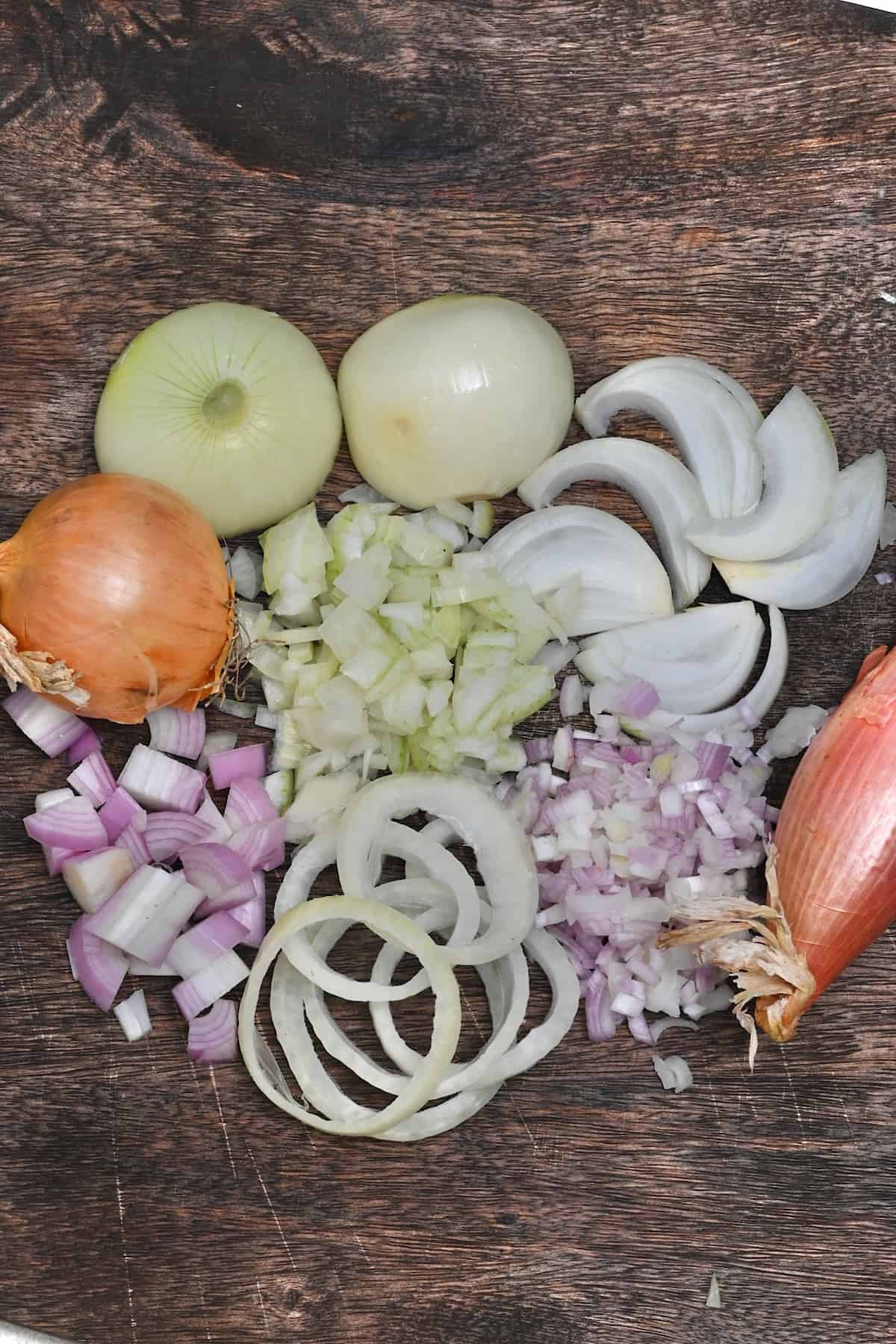
Along with garlic (check out how to chop garlic), onions are probably the other most common ingredient in my kitchen. This aromatic is perfect for adding to practically every meal for extra depth of flavor and deliciousness. But before we get to the good part, we first need to peel and chop it.
When done incorrectly, peeling onions becomes a monumental task; bits of papery peel remain stuck to the onion. And chopping the onions can lead to uneven (sometimes even injury-inducing) results and tears – literally. So instead, avoid the hassle and follow my easy step-by-step guide on how to peel an onion, store it, and properly cut an onion for any dish: rings, peeled, diced, minced, and grated!
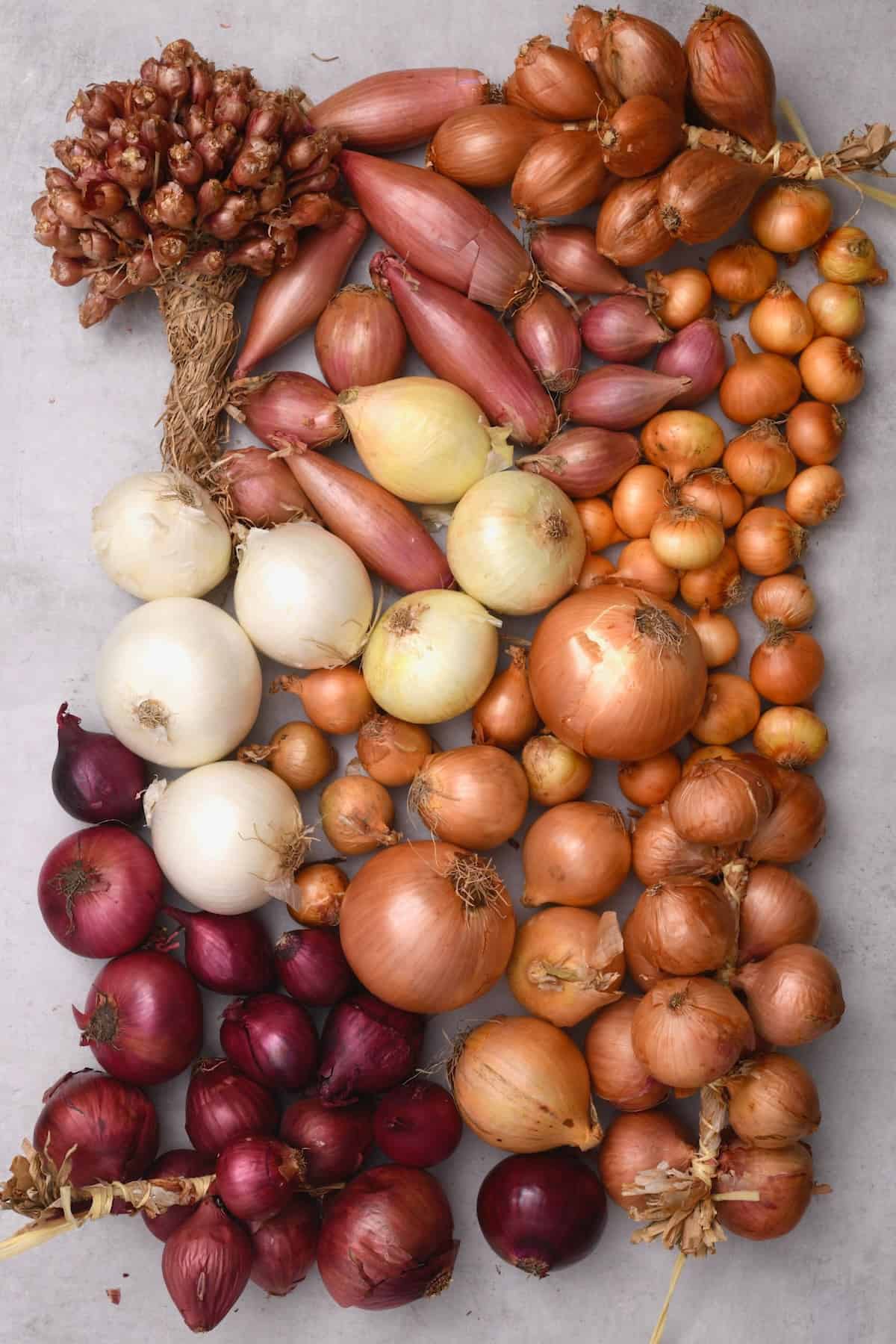
Want to save this recipe?
Table of Contents
- How many types of onions are there?
- How to tell if an onion is bad
- Are onions good for you
- How to peel an onion
- What kind of knife is best for cutting onions
- How to cut an onion
- How to cut onions without crying
- Best way to store onions (cut and whole)
- FAQs
- Onion recipes you will absolutely love
- How To Cut An Onion (Peel, Slice, Dice, And Chop) Recipe
How many types of onions are there?
While there are many different types of onions, the five main ones that I turn to for culinary uses are:
- White onions: Large and white-fleshed with a sharp flavor.
- Yellow onions: Versatile and common with white flesh and a tough brownish peel. Spicy and robust when raw but sweetened once cooked.
- Red onions: Purple rather than red and sweeter than white onions, perfect for salads, pickles, and when you want a burst of color.
- Sweet onions: Milder and sweeter than yellow onions, perfect for onion rings and milder flavor.
- Shallots: Smaller in size with pink-brown skin and light pinkish-white flesh. They are much milder than the other onions and great for enjoying raw or cooked.
Small shallots work well being peeled and minced like fresh garlic cloves.
- Pearl onions: (also called button, baby, or silverskin onions) These small onions are milder and sweeter than regular onion types and are usually eaten whole once roasted, glazed/caramelized, or pickled. They will also work in soups and stews.
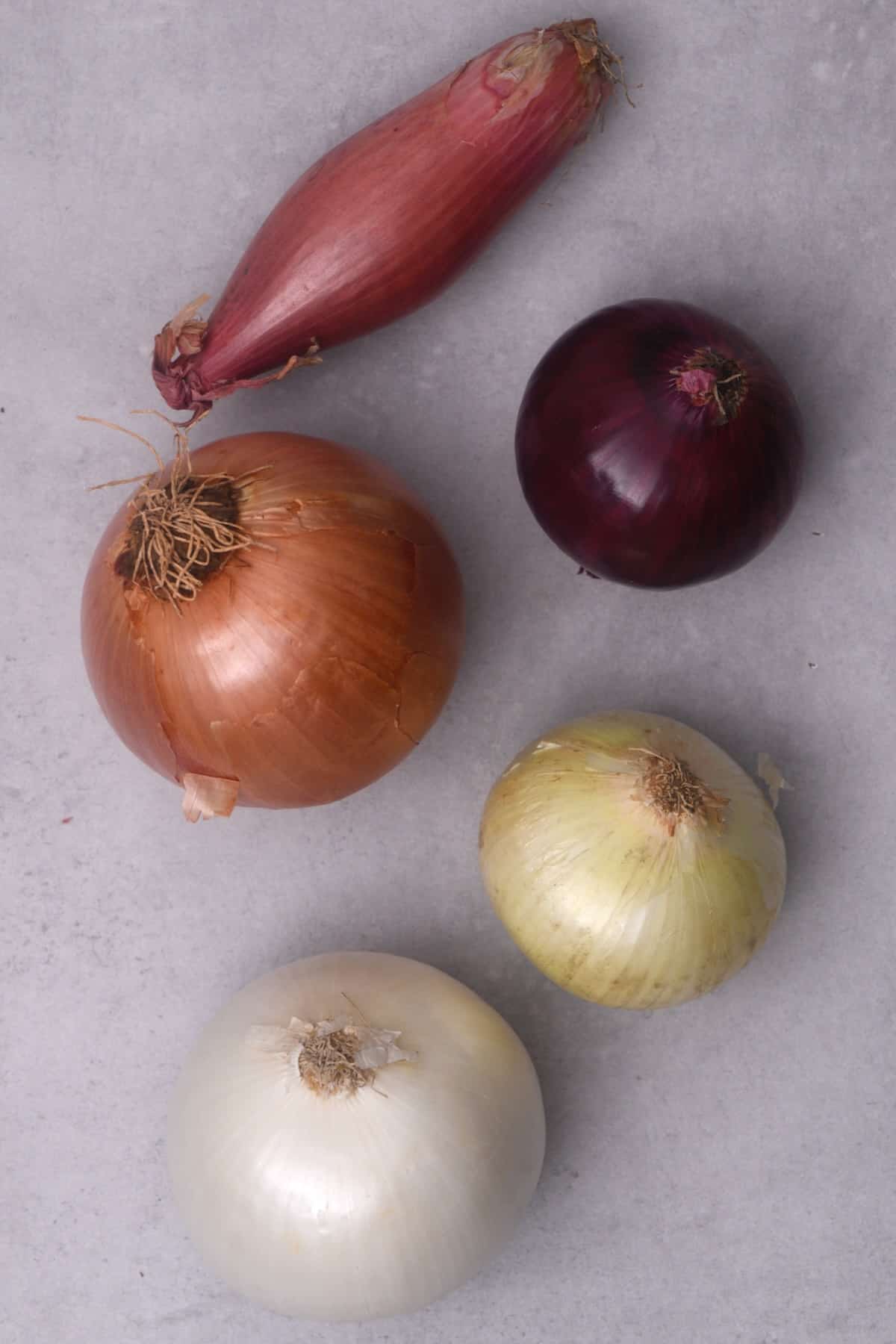
How to tell if an onion is bad
When selecting fresh onions, look and feel for firm onions with no wet spots or mushy/soft dark spots. Also, look for any gashes in the onion or mold.
Are onions good for you
Onions have a variety of benefits. They are a good source of vitamins and minerals. Plus, they contain antioxidants and may lower blood sugar levels and improve heart health.
Onions are also low in calories and a good source of fiber. It is important to note, though, that some people might suffer from indigestion and heartburn when consuming large amounts of onions.
How to peel an onion
Before chopping an onion, you’ll need to peel away the tough papery skin from the outside. However, it’s easiest to peel an onion after first making a cut or two.
- First, slice the onion in half vertically through the stem and root ends.
- Then, place the two halves cut-side-down on the chopping board and slice away about ½-inch of the stem end.
- At this point, the peel should come away easily. If it doesn’t, you can gently warm it against a hot pan for a short while to loosen the skin. OR peel away the entire outer layer of the onion (which is often tougher than the rest of the onion anyway).
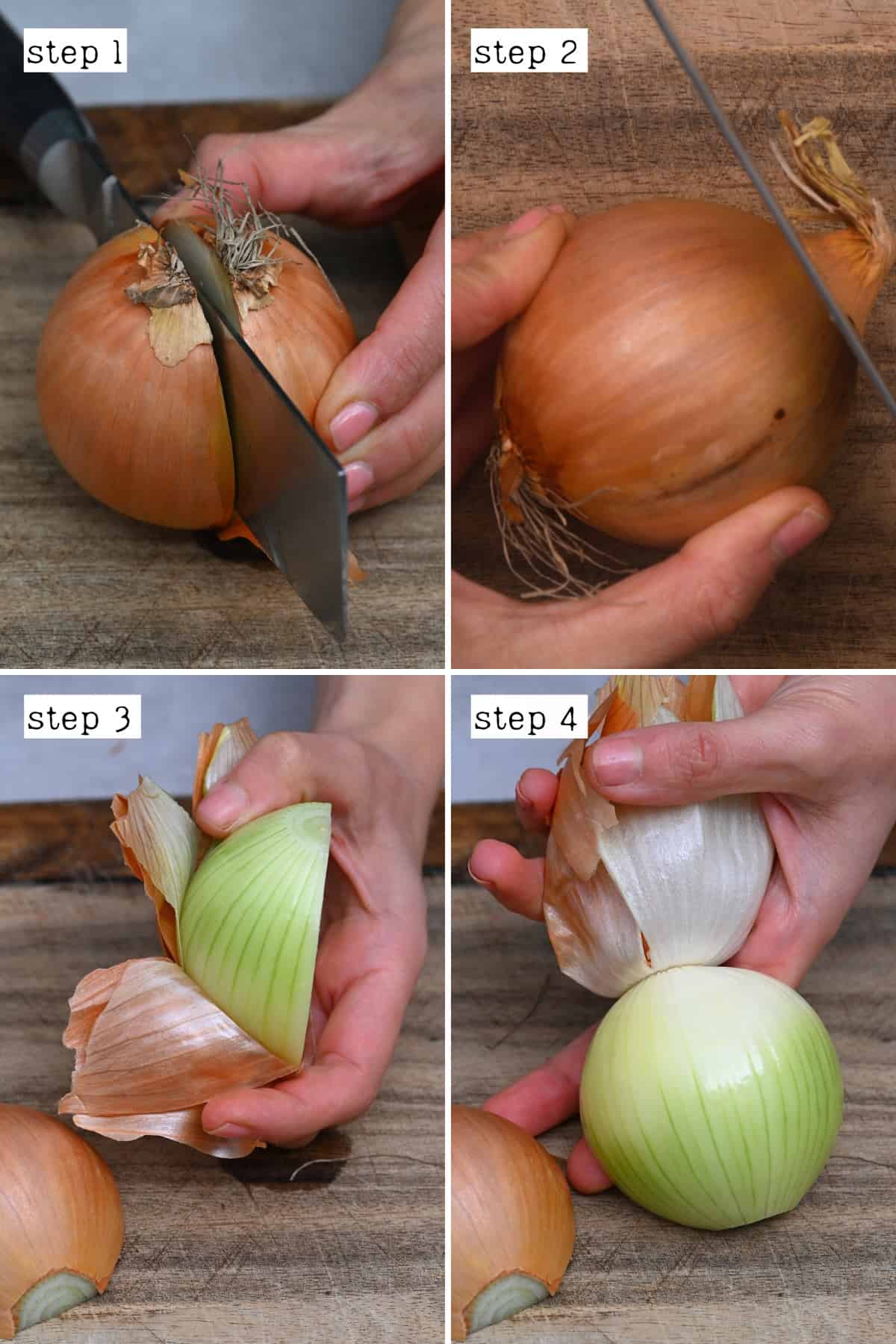
To peel a whole onion, slice the stem end. Then use the tip of the knife to carefully cut through the peel layer down both sides of the onion, making it easier to slide the knife under the peel and remove it.
Save the onion scraps to make vegetable stock or for your compost bin rather than discard them.
How to peel pearl onions
Because of their size, peeling pearl onions requires a slightly different tactic.
- With a sharp paring knife, slice off the root of each onion.
- Blanch the onions in a saucepan of boiling water for 2 minutes, then drain them.
- Transfer them to an ice bath until just cool enough to handle.
- Gently squeeze each onion at the stem end, and the onion should pop right out of the skin.
What kind of knife is best for cutting onions
The best knife for cutting onions is a very sharp knife! An 8-10 inch sharp chef’s knife, santoku knife, or a thin cleaver knife will work best. Avoid serrated and/or blunt blades, which can mash the onion, cut unevenly, and cause more tears and potential injuries.
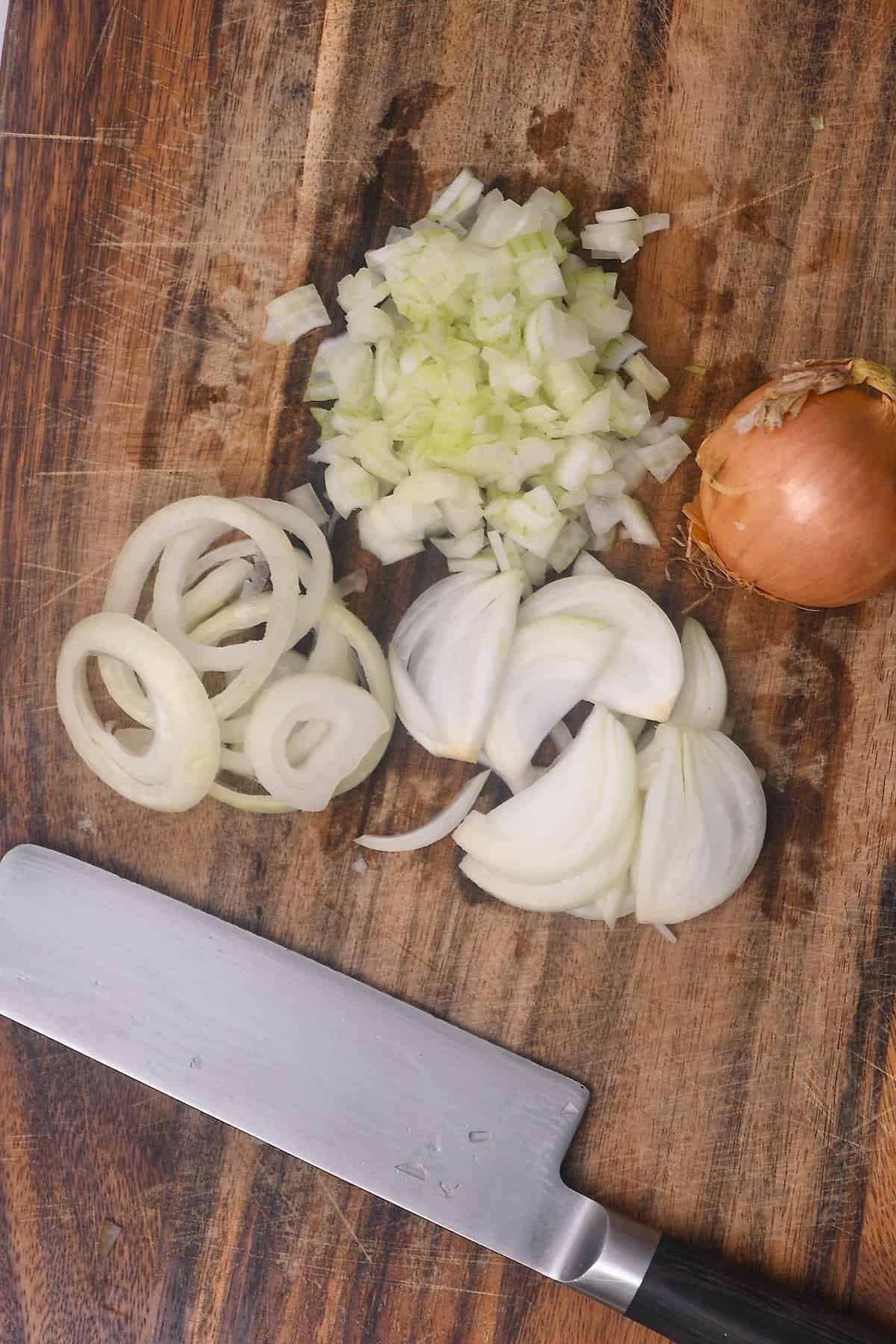
How to cut an onion
There are several ways how to chop an onion, depending on your final dish. This includes onion rings and slices as well as minced or diced onion. Keep reading for the simple step-by-step methods for the best way to cut an onion, no matter the dish.
How to Cut Onion Rings
To slice an onion into rings can be tricky because of its round shape. So here’s my preferred method.
- Start by slicing off the stem end of the onion and peel away the papery skin.
- Use one hand to hold the onion steady and the other to carefully slice the onion rings to your desired thickness.
To help steady the onion, optionally slice a tiny slither of onion from one side of the onion to lay on your chopping board.
- Once you’ve cut more than half the onion, it’s easier to change your grip, using your thumb and finger to hold together the sides of the onion, cutting between them.
Uses: Onion rings, caramelized onions, onion tarts, black bean burgers, etc.
How to Thinly Slice an Onion
There are two ways to slice an onion – pole to pole (think north and south pole on a globe), meaning root to stem, OR orbitally (aka crosswise). The former produces sweeter onion and ruptures fewer cell walls for less chance of tears. The latter is slightly easier to cut, though.
Pole to Pole Slices
- Chop the onion in half through the stem/root ends, cut away the stem end from each half (about ½-inch should do it), and peel away the skin. The intact root end will help hold the onion together while you cut.
- With the halves of the onion cut side down on the cutting board, use your non-dominant hand to hold it in place while using your other hand to make parallel slices in the onion to your desired thickness. Repeat with the remaining onion half.
Whenever slicing onion, protect your fingers by folding the fingertips in, so your knuckles are parallel to the knife, not your fingertips.
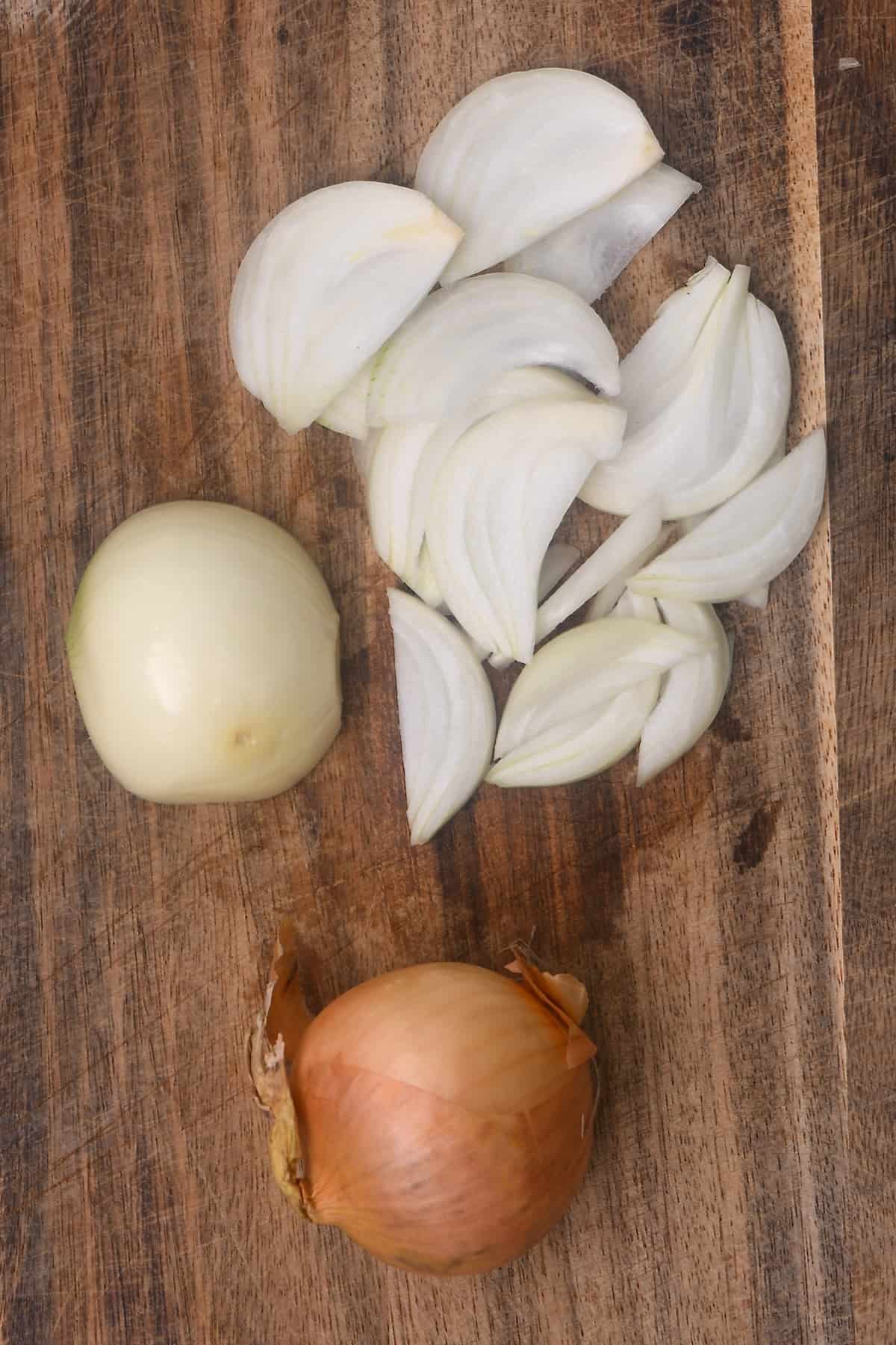
Orbital Slices
- Cut the onion in half and then slice off the root and stem end.
- Then use your non-dominant hand to hold the onion in place while you cut slices from root to stem.
Alternatively, halve and peel the onions, then use a mandoline for perfectly even sliced onion (or onion rings).
Uses: Thin slices make for great garnishes, in sandwiches and wraps, over pizza, for caramelized onion, making quick-pickled onions, salads, etc. You can use thick-cut onions for fajitas, burgers, stir-fries, etc.
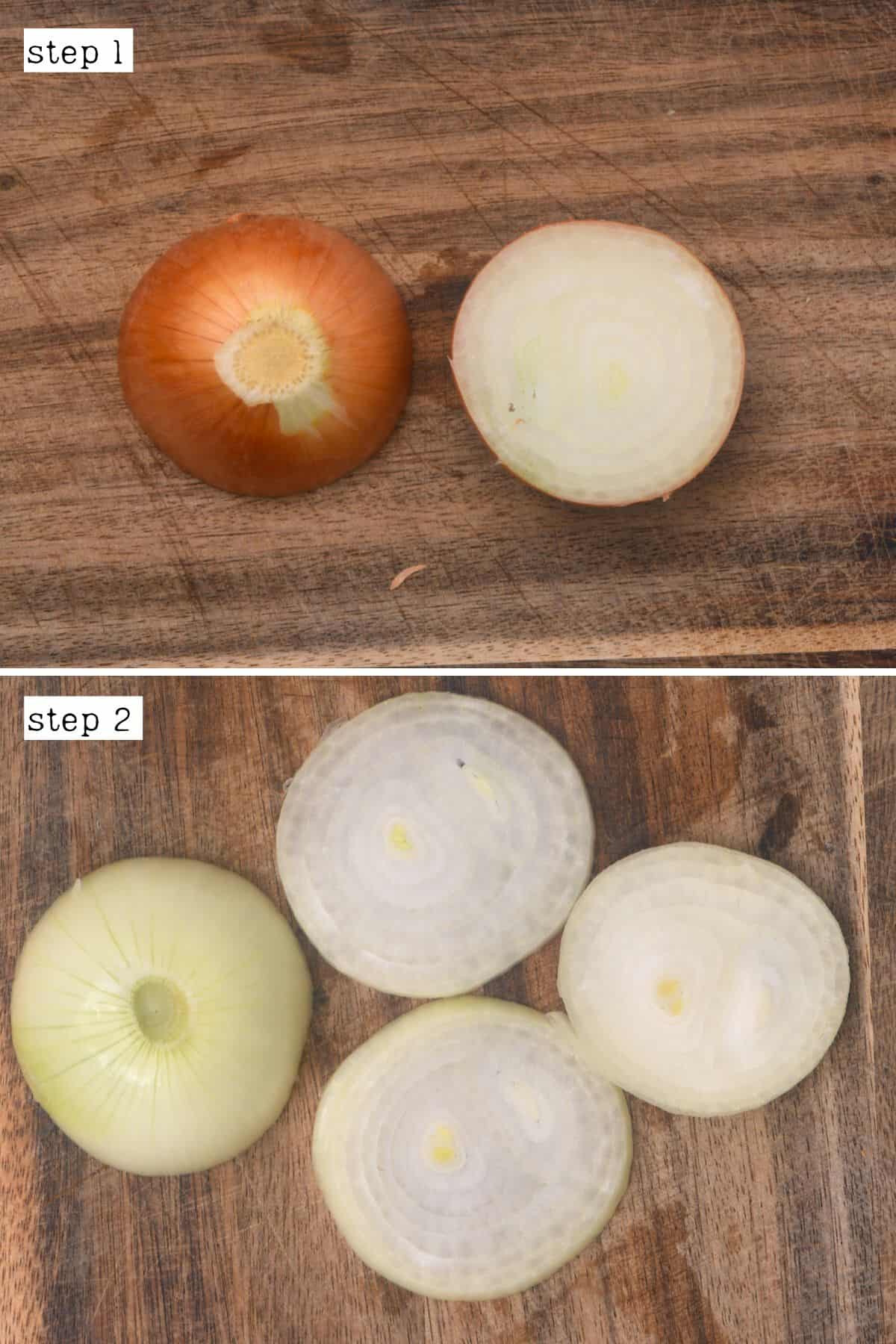
How to Dice an Onion
Like the above, dicing an onion (also called “chopped onion”) can be done pole to pole (the “traditional method”) or orbitally. The opinion of the best way to dice an onion comes down to personal preference.
Traditional Method
- Halve and peel the onion/s, slicing off the stem end.
- Place both onion halves cut side down on your chopping board. Then, working one at a time, use your sharp knife to make parallel slices across the onion from the cut stem end up to – but not through – the root end.
- Use your knife to slice 2-3 horizontal cuts from the stem end to the root, but not through it.
- Holding the onion firmly (keep the grip tight) with your non-dominant hand, use the other to slice across the onion, perpendicular to the first slices. When it gets tricky to slice, flip the onion forward so the new flat side is face down and continue to cut close to the root.
How thick/thin you make the slices through the top of the onion will determine how fine the diced onion pieces are. Roughly ¼ inch = small dice/finely chopped onion, ½ inch = medium dice, and ¾ inch is a large dice.
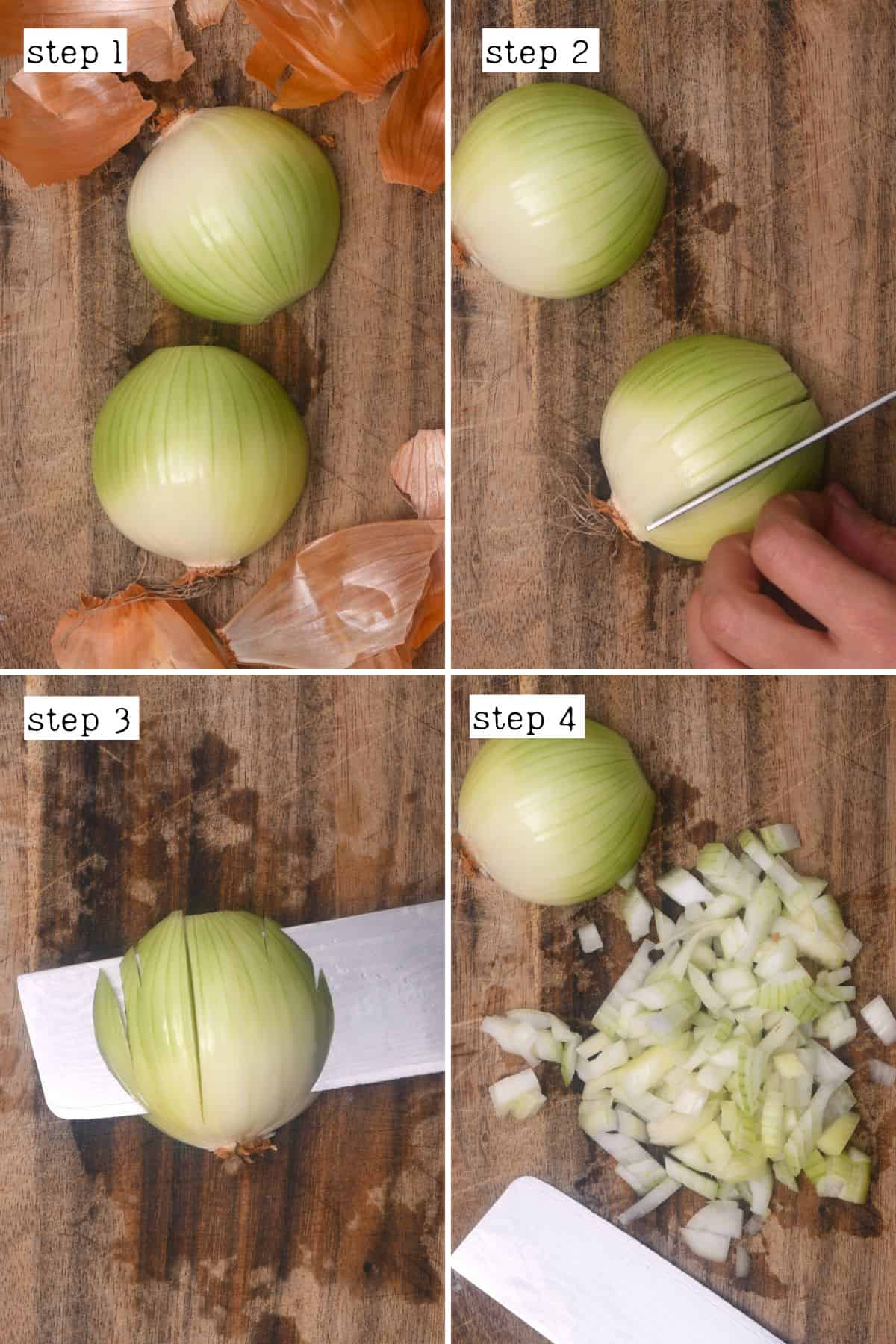
Angled Method
- Follow step one above. Then, when placing the onion halves on the chopping board, turn the onion so the root and stem ends are to the side and slice across the onion, but not all the way, as thick as you’d like.
- Flip the onion around, so the root and stem are on top and bottom rather than side to side. Use your knife to follow the natural grain of the onion. At the halfway point, flip the cut edge onto the board and continue to slice the rest of the onion. Finish off the top bit where you hadn’t cut through the onion entirely.
Alternatively, use a “food chopper” tool, which usually comes with a thicker and thinner grid pattern. Just slice the onions in half, peel them, and cut away both ends first. Then press them through the chopper.
Uses: Creating mirepoix (i.e., in soups and stews), in marinades, fresh salsa, salads, etc.
Chopped vs Diced – How Are They Different?
While similar, chopped onions usually aren’t as precise – they yield bigger, rougher chunks/cuts for roasts and stews. When you dice onion, the cuts are far more uniform/even.
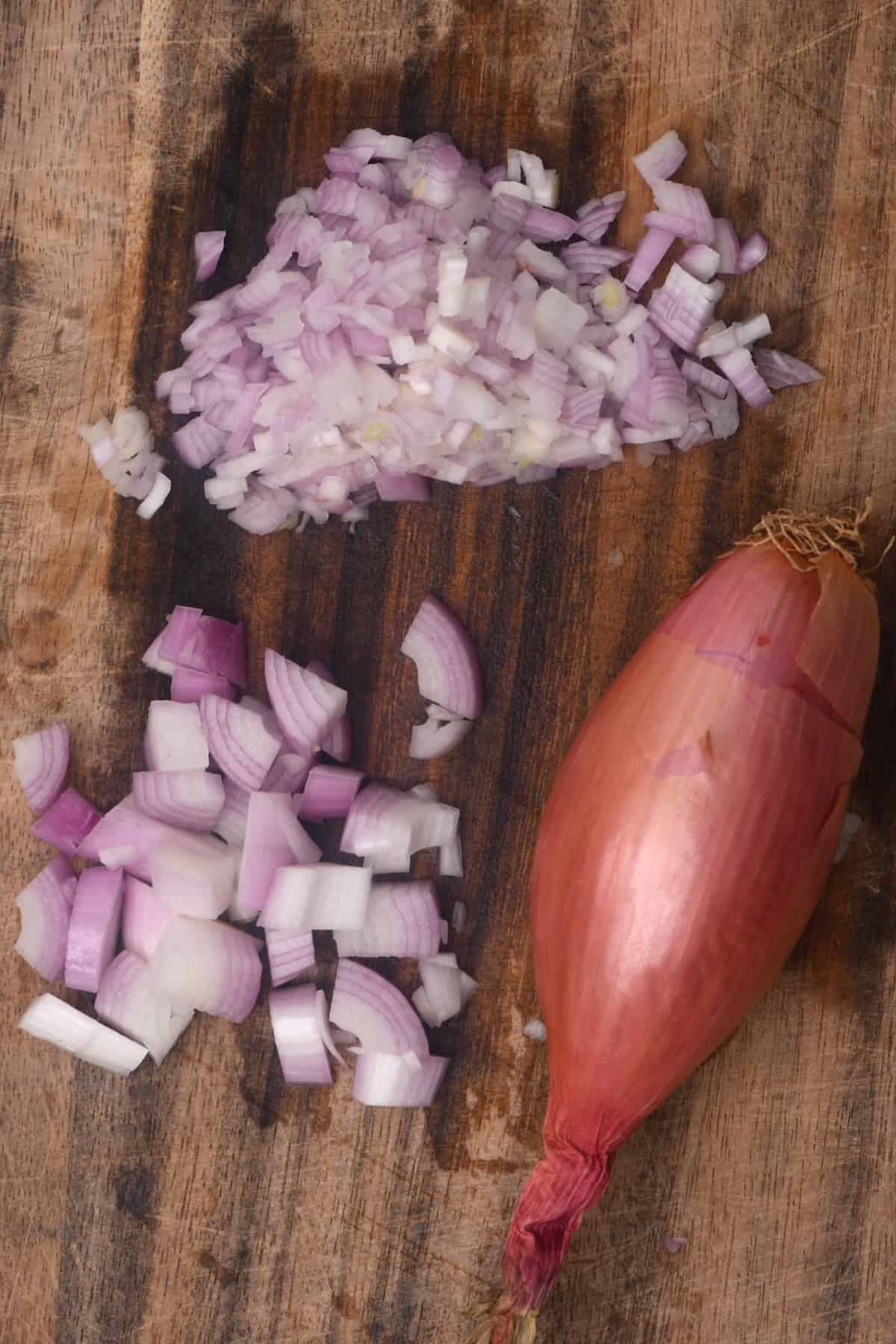
How to Mince Onion
- Follow the method for diced onion, making the slices in the onion very close together.
- After cutting, if the pieces are still too big, rock your knife back and forth (using your fingers over the top of the knife to help anchor it in place) over the onion to your desired consistency.
Alternatively, use a mini food processor for “instant” minced onions.
Uses: Minced onion is great for garnishing, in marinades and sauces, meatballs or meatloaf, etc.
How to Grate an Onion
For this method, you’ll need a box grater. You can peel the onion from whole or halved (after chopping off the stem end and removing the peel).
- Rather than standing the box grater upright, turn it on its side and place it over a dish or tray (to catch the shredded onion).
- Holding the box grater on the dish/tray, you can use your body weight to push the onion over the wider side of the grater and grate it.
Alternatively, use a grating disk in a food processor to get it done quickly and with minimal effort (though the cleanup is a little more annoying).
Uses: You can use grated onion in the same ways as minced, though it also works particularly well in things like savory pancakes.
How to cut onions without crying
Note that the more you slice/chop an onion, the more tear-producing gases will release into the air. So chopping the onion quickly and minimally is key. Also, use a sharp knife and leave the root end intact to avoid unwanted cell wall damage.
However, if you need a fine dice/mince – One of the best tricks I’ve come across to chop an onion without crying is to stick the peeled onions in the freezer for just 15 minutes. Then remove and chop them immediately. The cold slows down the chemical reaction to avoid tears.
Alternatively, you can leave the onion to soak in cold water after peeling it for 15 minutes (or chop it directly into the water) to stop the gas from releasing into the air. However, this will also make the onion taste milder, too.
And, yes, wearing swimming goggles (or other airtight goggles) can also help as you’re keeping the fumes out of your eyes entirely.
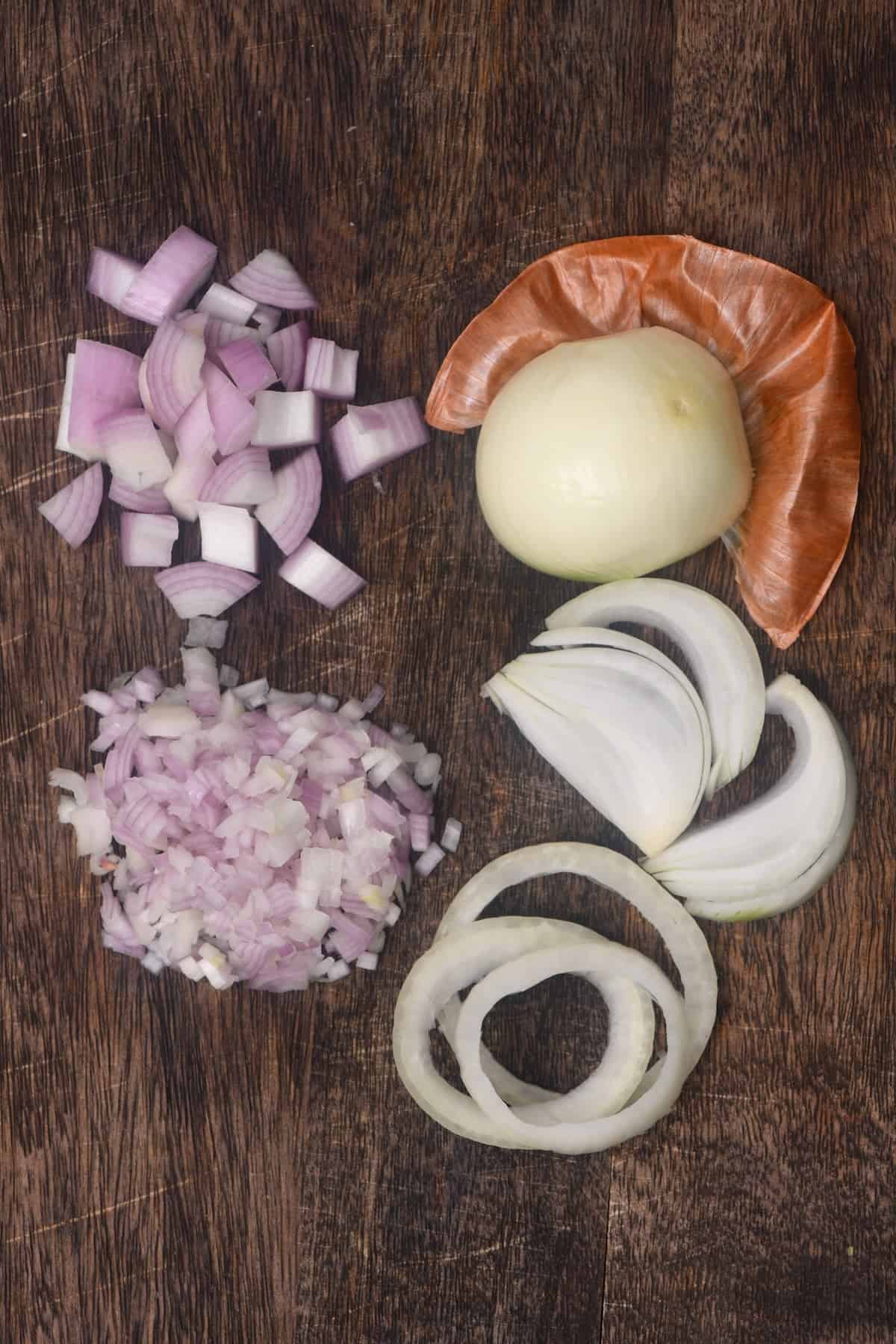
Best way to store onions (cut and whole)
Whole onions: Whole onions prefer a cool, dry, dark, and well-ventilated spot, like in your pantry in a fruit basket.
Peeled/cut onions: Once cut, store onions in a non-porous airtight container (like glass) in the refrigerator.
How Long Do Onions Last
Whole onions: They can last for between 2-3 months if stored correctly.
Peeled/cut onions: It’s best to consume them within 3-4 days, though they can last up to 5-7 days.
Does Onion Go in the Fridge
It is not recommended to store whole uncut onions in the refrigerator. That can cause them to spoil more quickly.
Can You Freeze Onions?
You can freeze raw sliced/diced/minced onion in the freezer for up to 3 months in an airtight Ziplock bag or smaller portions wrapped in plastic wrap. Use them from frozen or thaw them first.
FAQs
Onions contain sulfur compounds and an enzyme called synthase. When cut, they combine to create “syn-propanediol-s-oxide,” which releases into the air and irritates your eyes.
White onions are milder and sweeter. Yellow onions are more pungent. And red onions are milder, sweeter, and great for adding color to dishes.
Rub your hands on stainless steel to help remove some odor, then rinse with soap. Lemon juice or white vinegar (as long as you have no cuts) can also help neutralize the smell. Optionally add a small amount of salt, too, to make a scrub.
This helps to hold together all the onion layers, making cutting easier (otherwise, the layers can fall apart). As a bonus, keeping it intact means less potential for tears as that part contains the highest concentration of sulfur compounds.
To cut onions for burgers, I like to use medium onion rings or medium/thickly sliced onions (using pole-to-pole slices is best).
It’s chopped onions that are diced as finely as you can.
Onion recipes you will absolutely love
- Pickled Red Onions
- French Onion Soup
- How to Make Onion Jam
- Simple Roasted Onions
- How To Caramelize Onions
- Crispy Onions/Birista
- How to Make Onion Powder
If you try any of these methods for how to cut onions, let me know how it goes in the comments below. I’d appreciate a recipe card rating and would love to see your recreations – tag me on Instagram @Alphafoodie!
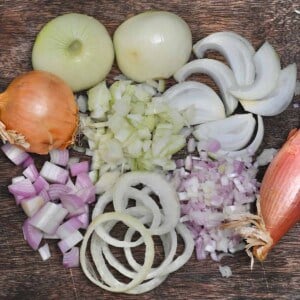
How To Cut An Onion (Peel, Slice, Dice, And Chop)
Equipment
- Sharp knife
Ingredients
- 1 onion or as much as needed
Instructions
How to Peel Onions
- Slice the onion in half vertically through the stem and root ends.
- Place the two halves cut side down on the chopping board and slice away about ½-inch of the stem end.
- At this point, the peel should come away easily. If it doesn’t, you can either gently warm it against a hot pan for a short while to loosen the skin OR peel away the entire first layer of the onion, too (which is often tougher than the rest of the onion anyway).To peel a whole onion, slice the stem end, then use the tip of the knife to carefully cut through the peel layer down both sides of the onion, making it easier to slide the knife under the peel and remove it.Note: how to peel pearl onion is described in the blog post.
How to Cut Onion Rings
- Slice off the stem end of the onion and peel away the papery skin.
- Use one hand to hold the onion steady and the other to carefully slice the onion rings to your desired thickness with a sharp knife.To help steady the onion, optionally slice a tiny slither of onion from one side of the onion to lay on your chopping board.
- Once you've cut more than half the onion, it's easier to change your grip, using your thumb and finger to hold together the sides of the onion, cutting between them.
How to Slice an Onion
- There are two ways to slice an onion – pole to pole (think north and south pole on a globe), meaning root to stem, OR orbitally (aka crosswise). The former produces sweeter onion and ruptures fewer cell walls for less chance of tears. The latter is slightly easier to cut, though.
- Pole-to-Pole SlicesChop the onion in half through the stem/root ends, cut away the stem end from each half (about ½-inch should do it), and peel away the skin. The intact root end will help hold the onion together while you cut.With the onion halves cut side down, use your non-dominant hand to hold it in place while using your other hand to make parallel slices in the onion to your desired thickness. Repeat with the remaining onion half.Orbital SlicesCut the onion in half and then slice off the root and stem end.Use your non-dominant hand to hold the onion while cutting slices from root to stem.Alternatively, halve and peel the onions, then use a mandoline for perfectly even sliced onion (or onion rings).
Traditional Diced Onion
- Halve and peel the onion/s, slicing off the stem end.
- Place both onion halves cut side down on your chopping board. Then, working one at a time, use your sharp knife to make parallel slices across the onion from the cut stem end up to -but not through- the root end.
- Use your knife to slice horizontally from the stem end to the root 2-3 times.
- Holding the onion firmly (keep the grip tight) with your non-dominant hand, use the other to slice across the onion, perpendicular to the first slices. When it gets tricky to slice, flip the onion forwards and continue to cut close to the root.How thick/thin you make the slices through the top of the onion will determine how fine the diced onion pieces are. Roughly ¼ inch = small dice/ finely chopped onion, 1/2=-inch = medium dice, and ¾-inch is a large dice.
Angled Method Diced Onion
- Halve and peel the onion/s, slicing off the stem end.
- When placing the onion halves on the chopping board, turn the onion so the root and stem ends are to the side and slice across the onion, but not all the way, as thick as you’d like.
- Flip the onion around, so the root and stem are on top and bottom rather than side to side. Use your knife to follow the natural grain of the onion. At the halfway point, flip the cut edge onto the board and continue to slice the rest of the onion. Finish off the top bit where you hadn’t cut through the onion entirely.Alternatively, use a "food chopper" tool. It usually comes with a thicker and thinner grid pattern. Just slice the onions in half, peel them, and cut away both ends first. Then press them through the chopper.
How to Mince Onion
- Follow the method for diced onion, making the slices in the onion very close together.
- After cutting, if the pieces are still too big, rock your knife back and forth (using your fingers over the top of the knife to help anchor it in place) over the onion to your desired consistency.Alternatively, use a mini food processor for ‘instant’ minced onions.
How to Grate an Onion
- For this method, you'll need a box grater. You can peel the onion from whole or halved (after chopping off the stem end and removing the peel).
- Rather than standing the box grater upright, turn it on its side and place it over a dish or tray (to catch the shredded onion).
- Holding the box grater to the lower dish/tray, you can use your body weight to push the onion over the wider side of the grater and grate it.Alternatively, use a grating disk in a food processor to get it done quickly and with minimal effort (though the cleanup is a little more annoying).
Video
Notes
Nutrition
Nutrition information is automatically calculated, so should only be used as an approximation.

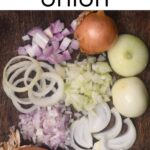
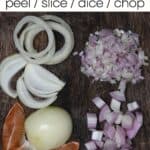
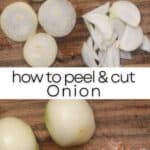
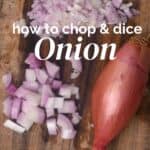
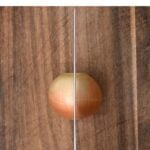









great uses of preserving onions
Thank you so much for your comment!